For this edition of Classic Steel, we are going to take a look back at Yamaha’s infamous 1984 YZ125.
For this edition of Classic Steel, we are going to take a look back at Yamaha’s infamous 1984 YZ125.
 |
|
In 1984, Yamaha introduced a bike so underwhelming it spawned a cottage industry of bad puns aimed at skewering its anemic performance. Underpowered, unreliable and unloved, the ’84 YZ125 marked a low point for Yamaha performance in the eighties. Photo Credit Yamaha |
Few bikes in the annuls of motocross history have been the butt of as many jokes as Yamaha’s pitiful 1984 YZ125. Slow to the point of comedy, the ’84 Y-Zed joins machines like the Suzuki TM400 Cyclone and Can-Am MX-3 “Black Widow” in the pantheon of motocross futility. Slow, fragile and immune to most efforts to improve its abysmal performance, the ’84 YZ stands as the low point in Yamaha’s proud 125 history.
 |
|
Gentleman Jim Holley always had a talent for making bikes look better than they really were. Photo Credit: Dirt Bike |
In many ways, the YZ’s pathetic showing was a bit of a surprise in ’84. In 1982, the YZ125 was actually the fastest bike in the class by a wide margin. It was overweight and handled like a Harley Softail, but boy did she scoot. In 1983, the YZ lost some of its top-end shriek in search for more meat in the middle. The new midrange motor was easier to ride, but not as fast as ’82 and most test riders lamented the missing revs.
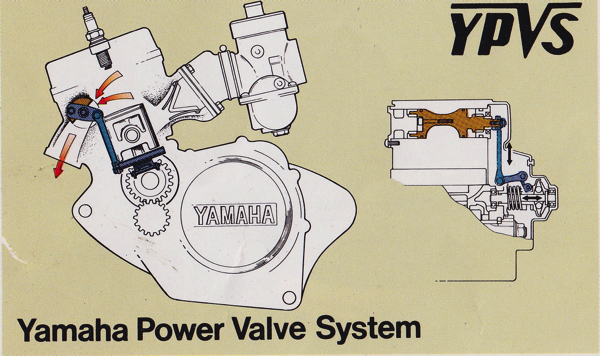 |
|
Yamaha was the first manufacturer to put a power valve equipped two-stroke into production in 1982. While the system certainly showed promise, early designs failed to make the most of its performance potential. Photo Credit Yamaha |
For ’84, Yamaha looked to build on the mid-range power it found in ’83 and try to bring back some of the over-rev it had in ’82. In order to accomplish this, they added two additional ports to the exhaust side of the barrel and installed a boost port to the intake side that bypassed the reed valve and fed the charge directly into the crankcase. Minor revisions to the YPVS (Yamaha Power Valve System) improved sealing and a new pipe was bolted on to allow better scavenging of exhaust gasses. Topping off the motor changes for ‘84 were a larger air filter element and a 2mm larger carburetor for increased flow.
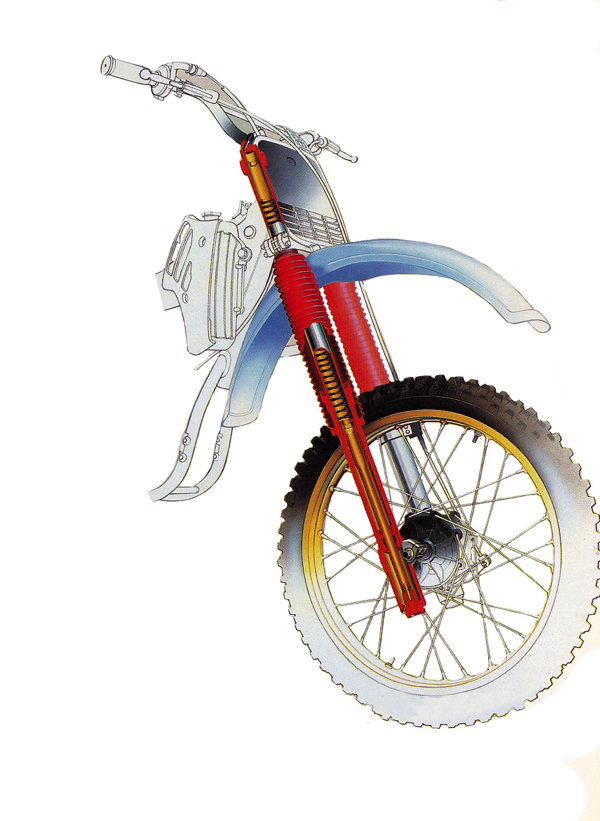 |
|
New front forks for 1984 bumped up the size from 38mm to 43mm and brought the 125 up to speed with the rest of the full size YZ’s. The larger diameter tubes promised improved steering precision, less flex under braking and reduced deflection on hard hits. Photo Credit Yamaha |
While all this sounded promising on paper, in practice, it turned out to be a massive misstep. The new power plant mimicked the mid-range power curve of ’83, but lacked the previous year’s impressive burst. Off idle, the new YZ was a massive sea of bog, requiring the rider to fry the clutch just to get moving. Once into the midrange, the bike made sounds like it wanted to go, but there was no sensation of acceleration to speak of; just a change in tone and a slight bump in forward motion. Once past this little flurry of excitement, the little Y-Zed completely fell on its face. There was no pull past the midrange and winding it out only made it go slower.
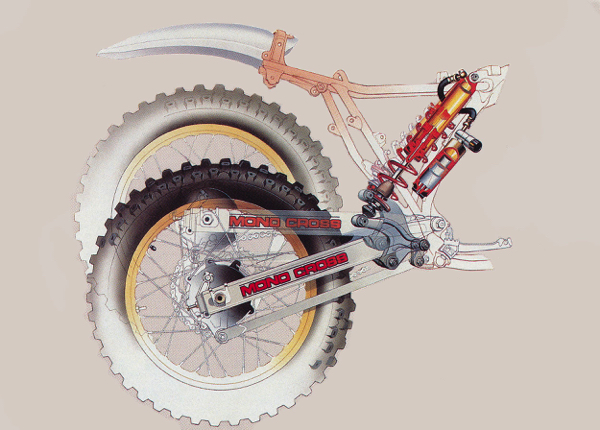 |
|
The new Monocross rear suspension for ’84 offered revise damping, a smoother linkage curve and a more compact profile. Photo Credit Yamaha |
The bike was so slow that initially some testers thought there must be something wrong. On top end, MXA commented that the bike sounded as if it was “asthmatic and hacking” and Dirt Bike noted that the YZ was incapable of outrunning the 80cc class of 1984. In a drag race, the ’84 CR125 (no rocket in its own right) would pull the lowly YZ by four to six bike lengths through the gears. Against the blazing fast ’84 Kawasaki, it was no contest as the KX waived bye-bye after three feet and never looked back.
 |
|
Nearly all-new from the ground up, the 1984 YZ125’s spec sheet made a lot of promises its performance could not hope to back up. Photo Credit: Moto Cross magazine |
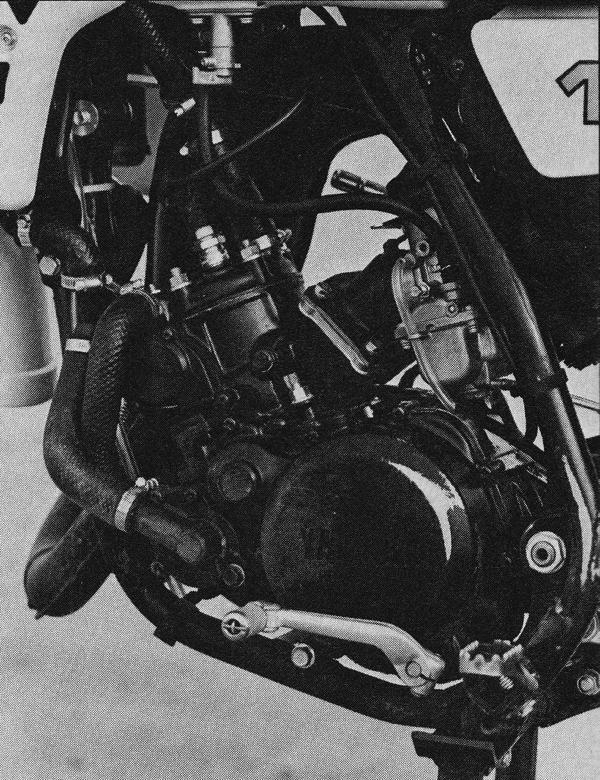 |
|
In 1983, the YZ’s motor was fast, but its powerband was narrow and tricky to ride fast. A bigger carb, two additional exhaust ports, an additional boost port and a freer flowing exhaust were all on the agenda for 1984 in search of the 1983’s missing top-end power. Photo Credit: Moto Cross magazine |
Making matters worse for unlucky YZ pilots in 1984, was the Yamaha’s uncooperative gearbox. Grabbing gears on the Yammer was like ramming a ball bat through a bucket of bowling balls. The bike refused to be power (using that term lightly, of course) shifted under any circumstances and a liberal dose of clutch was mandatory to grab the next cog. Because its powerband was so narrow and output so meager, being in the right gear was critical and miss-timing a shift was paramount to throwing out a boat anchor. If you shifted to soon, it bogged. If you waited too long, it wheezed.
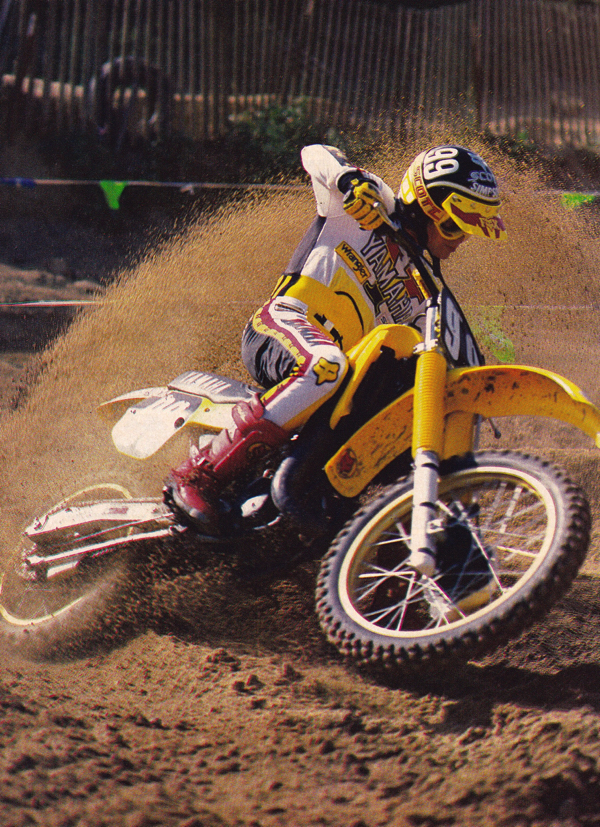 |
|
In 1984, Mike Beier took a heavily modified YZ125 to third place in the final 125 National Motocross standings. Mike’s bike used an in-house modified Yamaha cylinder paired with a special Boyesen reed cage and P.S.I. pipe to deliver a high-revving style of power. For his suspension, he used stock Yamaha components modified by Paul Thede of Race Tech. Photo Credit: Moto Cross magazine |
Perhaps worst of all, the motor proved both unreliable and virtually impervious to improvement. In stock condition the YZ was prone to overheating and seizures were common. Doubling up on the head gasket was a common band aid for the chronic detonation and Yamaha’s “Wrench Report” recommended altering the ignition timing and adding four holes to the baffle plate around the main jet to keep the YZ from grenading itself under stress. Savvy riders also learned to carefully inspect each piston for imperfections and sand down any high spots to prevent it catching on the exhaust port.
 |
|
Crash landing: The caption says it all. Photo Credit: Dirt BIke |
This slowness issue proved harder to remedy than one might expect. Usually a trip to a skilled tuner was all that was necessary to extract a few extra ponies, but the ‘84 YZ proved an unwilling participant. Porting the stock cylinder and adding a pipe did little to nothing for the YZ’s meager output. Eventually, tuners learned that a switch to the ’83 cylinder yielded better results, but even with this expensive mod ($300 in 1984), the YZ was never going to be in the same zip code as the powerhouse KX.
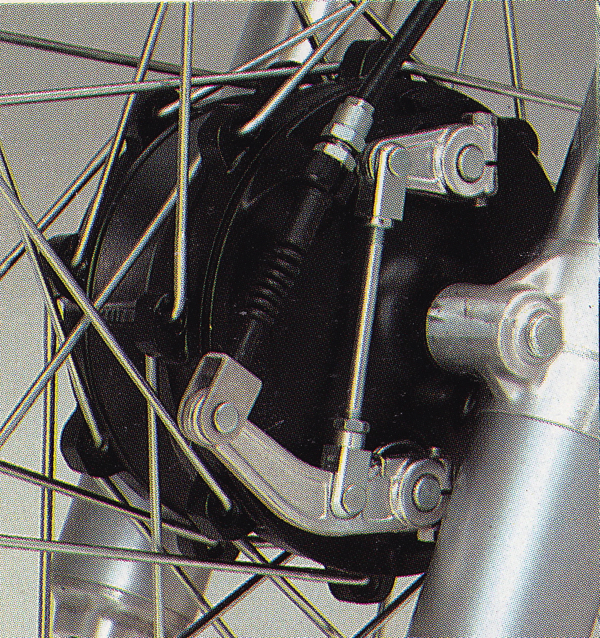 |
|
A day late and a dollar short: In 1984, the YZ125 finally inherited the excellent dual-leading shoe binders that had previously been exclusive to the YZ250 and YZ490. While these new brakes worked incredibly well for drums, they paled in comparison to the high tech front discs found on the CR125R and KX125. Photo Credit: Yamaha |
In the chassis department, Yamaha spec’d an all new frame for ’84. The new chassis moved the motor forward 30mm and repositioned the steering head 14mm down and 31mm back for improved turning. A new longer swingarm (38mm) and revised Monocross linkage with a shorter overall shock (47mm) revised the bike’s weigh distribution and gave it a more compact layout. The new radiators were mounted lower to improve handling and bolted to a revised tank with increased capacity. Lastly, a new seat was bolted on and paired with a set of Bold New Graphics for ‘84
 |
|
Gyro Gearloose: In 1984, Yamaha literally tried to re-invent the wheel with the introduction of their new Z spoke design. The Z spoke used a single spoke which ran from one side of the wheel to the other and passed through a small channel in the hub. The promise of the Z spoke was greater strength, less flex and lower maintenance. Photo Credit: Yamaha |
On the track, the new chassis proved nearly as much of a disappointment as the motor. Overall handling was vague and the front end exhibited a push that never quite went away. The low seat, high bars and steep tank made getting forward in the turns an arduous task, and just moving around took more effort than the other brands. Stability was only mediocre and the bike still liked to exhibit a nasty hop at inopportune moments. In its 1984 125 shootout, Dirt Bike magazine proclaimed that the YZ “steers fuzzy and lends no confidence,” concluding that it generally “has a mind of its own.” Considering that slow bikes usually handle well, this was no small feat and the YZ was honored with the distinction of being both the slowest and worst handling tiddler of ’84.
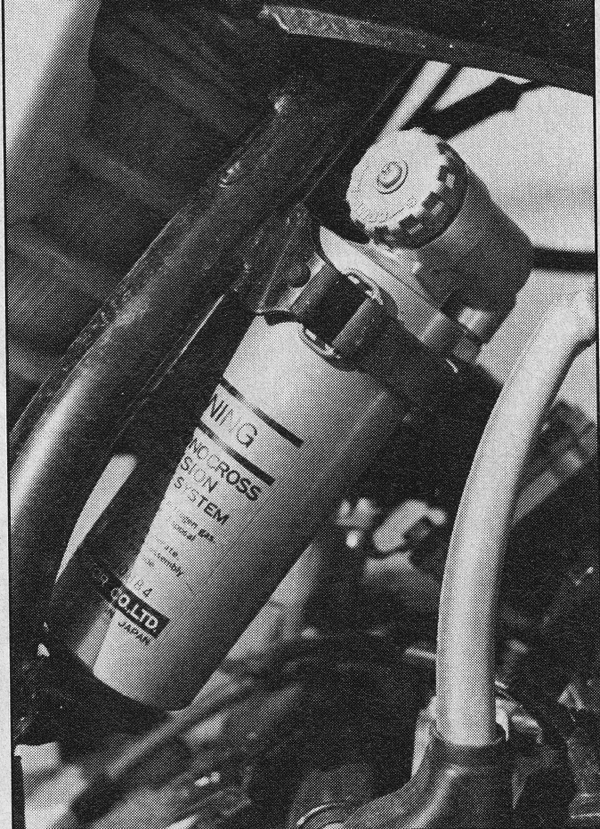 |
|
One welcome change for 1984 was the repositioning of the compression adjuster from under the seat (where it required removal of the saddle for adjustment) to the body of the remote reservoir where it could be easily accesed. Photo Credit: Yamaha |
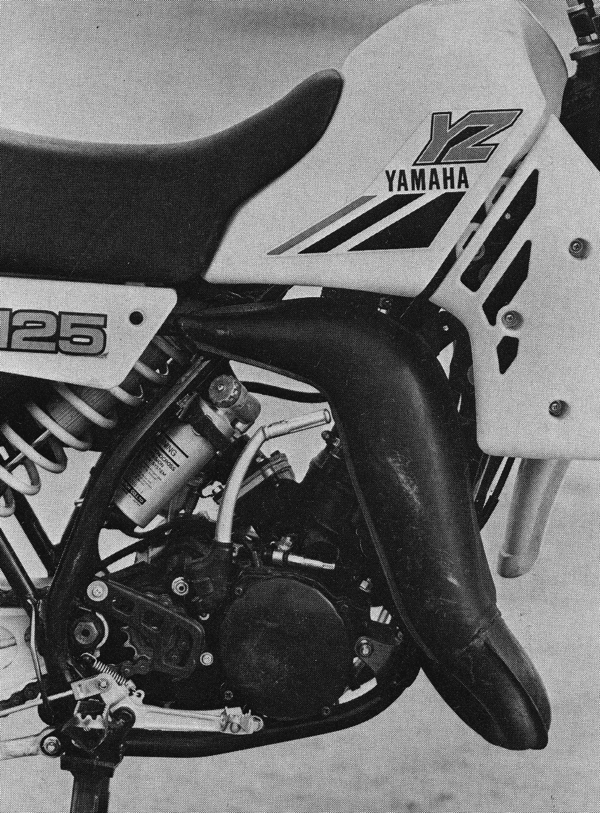 |
|
Asthma attack: Instead of broadening the power of their punchy ’83 mill, all Yamaha succeeded in doing for ’84 was ruining the motor’s one good trait. The new motor was completely gutless down low and choked off on top. Its only useable power was situated dead center in a modest 1000 rpm burst. At a meager 21 horsepower, it gave up 4-5 horsepower to the fastest bikes in the class and did so over an incredibly narrow spread. Photo Credit: Moto Cross magazine |
In the front suspension department, the YZ got some important upgrades for 1984. A switch to 43mm forks from the 38mm units of ’83 increased rigidity and brought the 125 up to speed with its 250 and 490cc stable mates. Travel was set at 11.8” and the new forks featured both air and compression damping adjustability, but no external rebound damping adjustment.
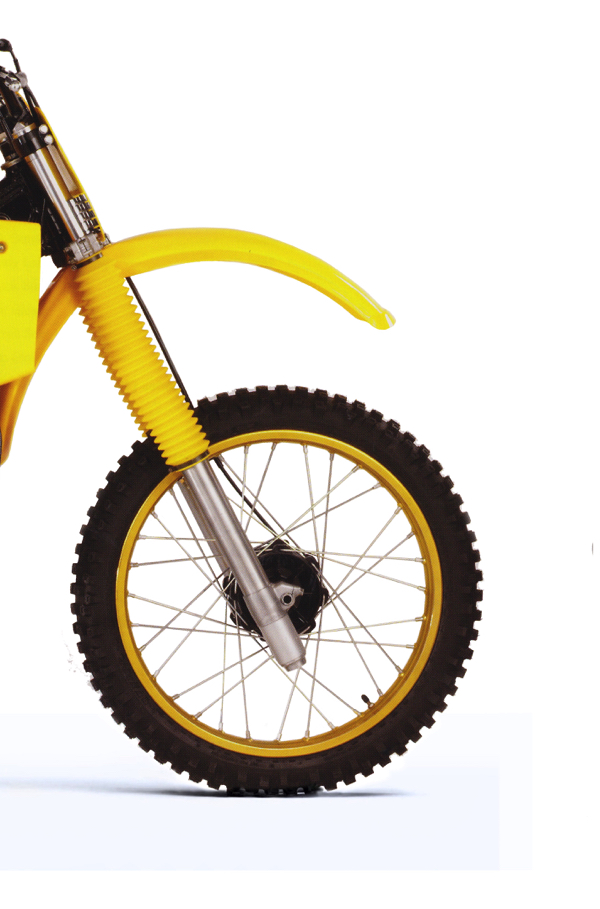 |
|
The new 43mm forks on the YZ proved one of the bike’s few bright spots. While not particularly plush, they were more than adequate to handle the modest speeds the bike was capable of attaining. Photo Credit: Yamaha |
In terms of performance, the YZs new forks were actually pretty good by ’84 standards. The beefy new legs offered less flex and more precision under a load. They were less prone to deflect on hard hits and less vague under braking. Both the spring rate and damping were well suited for the bikes target audience and most riders liked them in stock condition. They were not as plush as the excellent KYB’s found on the Suzuki, but neither was anything else in the class.
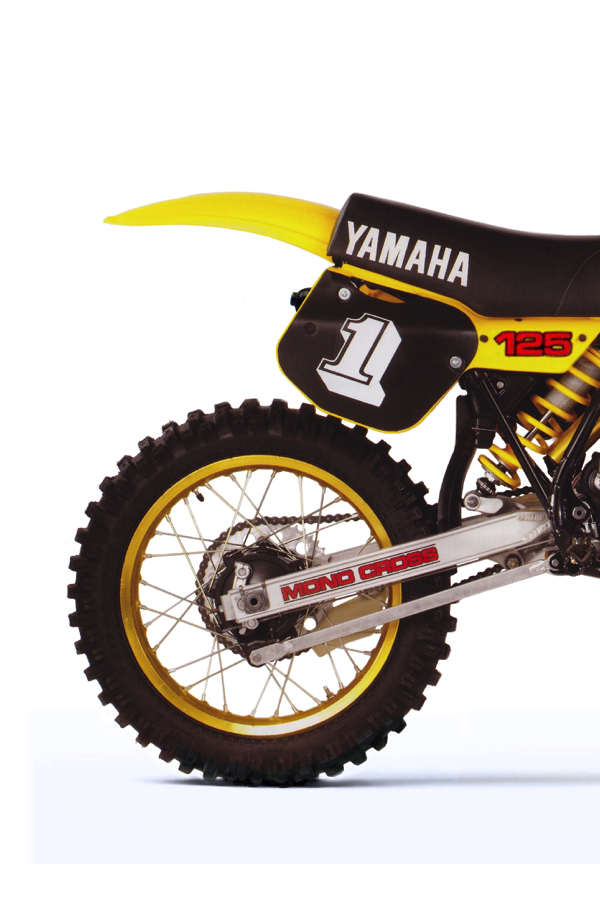 |
|
The new Monocross rear on the YZ was not as well liked as the forks. It did well on big hits, but delivered a choppy ride on anything else. Photo Credit: Yamaha |
Out back, a revised Monocross rear suspension offered slightly less travel and a smaller overall footprint for 1984. Both the shock body and remote reservoir were smaller to save weight and allow a narrower midsection. In addition to taking up less space, the new shock was easier to adjust, with the compression adjuster moved from below the seat to a knob on the reservoir body. Rebound damping remained the easiest to access in the class, with a large dial placed at the base of the shock needing no tools to adjust.
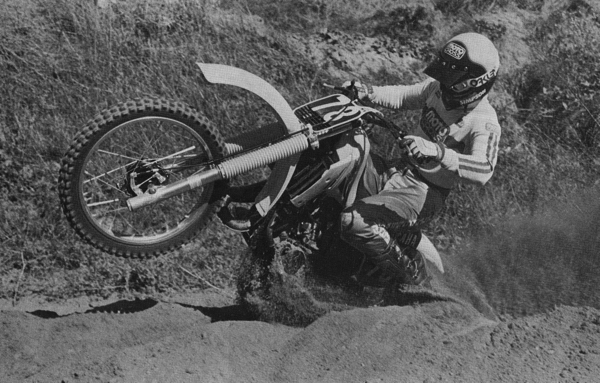 |
|
Deep sand and loam was not your friend on the ’84 YZ. If you let it fall off the pipe, it was likely to be next week before you got back up to speed. Photo Credit: Moto Cross magazine |
While the new shock offered a dizzying amount of adjustability, none of it seemed to do much for its lackluster performance. The Monocross proved adept at taking big hits, but small whoops and chop left it confused. No amount of sag adjustments or dial spinning seemed to lessen its harsh feel. Sharp hits often caused it to rebound violently and the bike could develop a nasty side-to-side swap in the rough. Overall, it was rated at the bottom of the class for its busy ride and proclivity for attempting to eject its pilot.
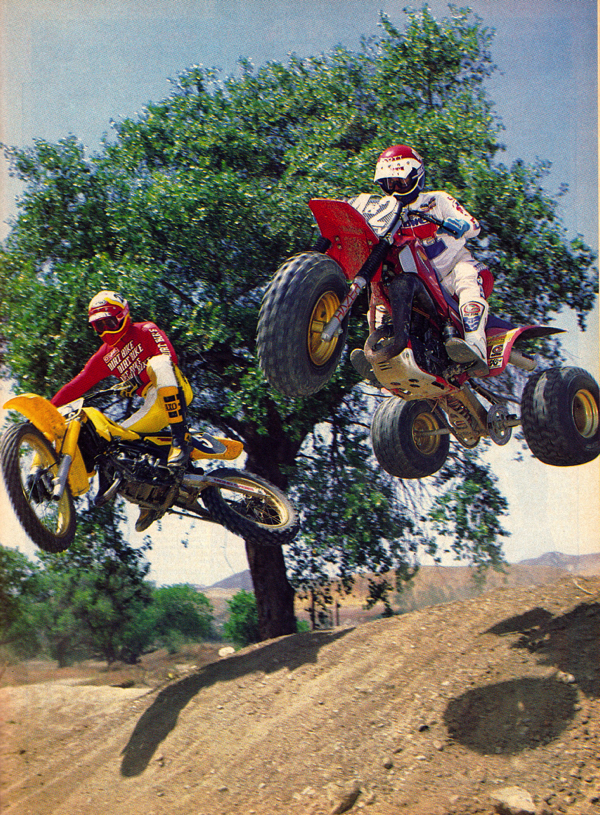 |
|
What is yellow and black and can’t outrun a trike? Photo Credit: Dirt Bike |
In the details department, the YZ was a mixed bag. The upgrade to a dual-leading shoe front binder was a significant improvement for 1984, but of course, it still paled in comparison to the discs found on the Honda and Kawasaki. Yamaha’s new rim-to-rim “Z-spoke” was big news for ’84, promising greater strength, less flex and lower maintenance. In practice, they turned out to be a nightmare. The one piece spokes got loose constantly and cracked the hubs at the pass through point. Add in a set of butter-soft rims, and you have a recipe for a lot of wheel failures in ’84.
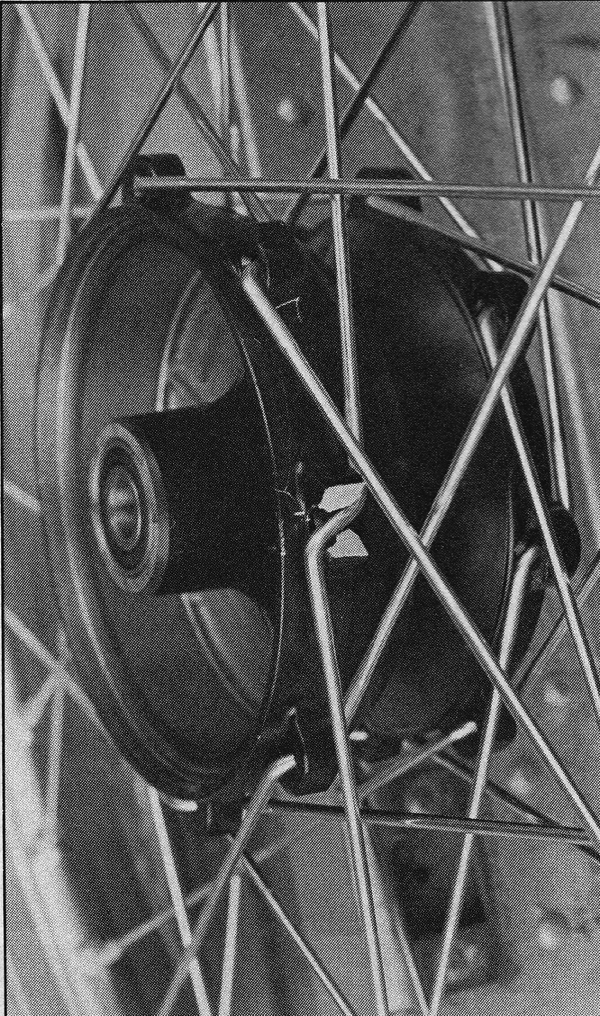 |
|
Crack up: The new Z spoke wheels while novel in concept, proved fragile in practice. It was a constant battle to keep them from coming loose and if they were not watched like a hawk, broken hubs were the result. Photo Credit: Motocross Action |
The new radiator shrouds tucked in much better and snagged a lot less boots than ‘83, but most riders disliked the “sit in a hole” saddle and its instantly sacking foam. Both the odd sweptback bend of the bars and stock grips received resounding thumbs down for their propensity to cause blisters on the inside of your throttle hand. On the plus side, the new plastic proved much more resistant to exploding in a crash and the new side access airbox made filter servicing less of a chore.
 |
|
The 1984 Yamaha YZ125 (shown here it its lovely international colors) was a bike so bad it stained Yamaha’s reputation for over a decade. Pathetically slow, perilously brittle and practically worthless as a racing contrivance, the ’84 YZ125 remains to this day one of the most epic fails in motocross history. |
Even thirty years later, the sting of the ’84 YZ125 runs deep to the poor souls who plunked down their hard earned $1899 for this epic turd. In 1984, Dirt Bike magazine led their test of the YZ125 by proclaiming that “Last year’s rocket is this year’s rockette.” Gutless, unreliable and poor handling, the ’84 YZ proved fertile ground for editors looking to turn a phrase at the Yamaha’s expense. Comparisons to riding lawn mowers, snails and attempts to feed the bike dog food (Yama-dog anyone?) were common occurrences in ’84 (and ’85 for that matter). For those unlucky enough to be saddled with the YZ, it proved an absolute money pit of wasted hop-ups and shattered parts. In 1986, Yamaha would finally get the ship righted once again with a much improved (and finally FAST) YZ125. While it would lose out in the final standings to Honda’s unbeatable ‘86 CR125R, at least it was finally in the conversation. This was certainly something that could never have been said about the 1984 YZ125. Unfortunately, in ’84, the YZ had to be content with being the butt of the joke.
For your daily dose of classic moto goodness, make sure to follow me on Instagram and Twitter @tonyblazier
For questions or comments, feel free to drop me a line anytime at TheMotocrossVault@Gmail.com





